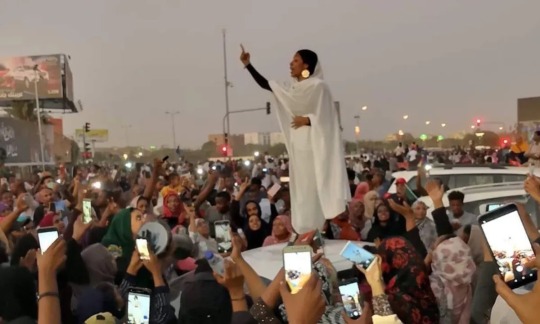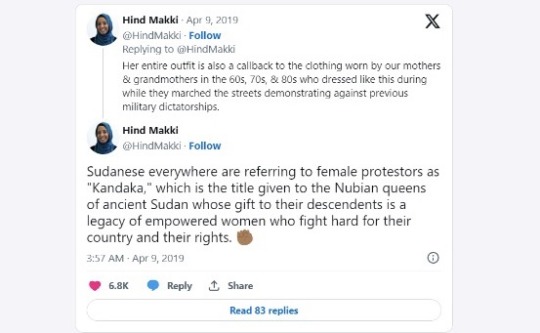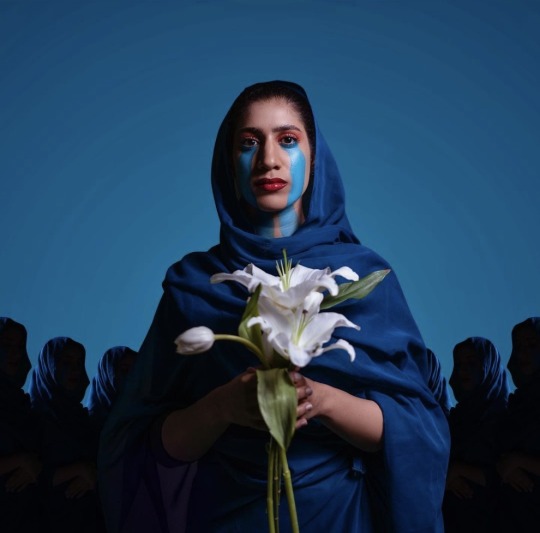#sudaneserevolution
Explore tagged Tumblr posts
Text
From Streets to Symbols: Unveiling the Power of Graffiti, Art, Music, and Culture in Protest Movements – A Spotlight on the Sudanese Revolution
Have you ever found yourself associating a dance move with a particular era or linking a pose to a significant cultural moment? Such connections often transcend the boundaries of the physical, seeping into the realms of art, music, and cultural symbols. In Sudan, the evolution of symbols during the revolution was nothing short of poetic. The Sudanese revolution of 2019 serves as a compelling canvas where these forms of expression converged, giving rise to the Kandaka with the white toub—a powerful symbol of resistance that echoed the collective voices of a nation yearning for change.

Graffiti and Street Art as Voices on Walls
During Sudan’s 2019 revolution, as people mobilized across the country with sit-ins, marches, boycotts, and strikes, artists helped capture the country’s discontent and solidify protesters’ resolve (How Art Helped Propel Sudan’s Revolution, n.d.). What started as protests against rising food and fuel costs turned into a coup where millions marched to overthrow al-Bashir after 30 years in power.
Artists became an integral part of the months-long sit-in at the military headquarters in Khartoum, known as the heart of the revolution. This expression of creativity was both a result of loosening restrictions on freedom of expression and a catalyst for further change.
Artists throughout Sudan used graffiti to spur conversations about the trajectory of the country and also used murals to share information about dates and times of protests. Jonathan Pinckney, program officer and research lead for USIP’s program on nonviolent action, pointed out that art has played a role in many major nonviolent struggles to create a shared vocabulary (How Art Helped Propel Sudan’s Revolution, n.d.).

Hussein Merghani’s watercolor of hundreds of people from Atbara traveling to join the sit-in at the military headquarters in Khartoum in April 2019.

A mural by Galal Yousif near the sit-in site reads “you were born free, so live free.” (Sari Ahmed Awad)
Visual Arts and Popular Culture: The Kandaka and the White Toub:
In a society where patriarchy and male dominance prevail, it's quite surprising that a woman emerged as a symbol of protest. The kandake, breaking stereotypes, became an iconic figure, showcasing the resilience of Sudanese women who have long been leaders in the country’s revolutions. Since 1989, when Omar al-Bashir seized power, women faced curtailed rights under vaguely defined moral and penal codes, notably the 1991 Public Order Laws dictating women's public conduct, movement, and even clothing. Despite these oppressive measures, women persisted in their fight against al-Bashir's rule, playing a pivotal role in mobilizing protests.
This resilience found a remarkable face in a young student named Alaa Salah, captured in a moment of protest wearing a white toub and traditional jewelry. Standing atop a car, she passionately chanted revolutionary poetry, expressing the collective frustrations: “They imprisoned us in the name of religion, burned us in the name of religion … killed us in the name of religion,” met with the resounding response of “revolution” from the crowd (Ismail and Elamin 2019). This powerful image swiftly went viral in Sudan, becoming a catalyst for countless Sudanese artworks, ranging from political caricatures to paintings to graffiti on Khartoum's streets.

What makes this image truly iconic is the symbolism embedded in the white toub—a garment worn by women of all classes, considered a democratic attire that doesn't conform to strict piety rules promoted by Islamists. Urban upper- and middle-class women, by embracing the toub, transcended ethnic and social differences, actively promoting unity. The resonance of this image extended beyond its visual impact, inspiring a wave of artistic expressions that echoed the collective call for change on the streets of Khartoum.

The Digital Canvas: Social Media as the New Protest Wall
When delving into the role of digital communities and social media in amplifying protests, particularly within Sudan, one cannot overlook the pivotal role online communication played during the revolution. However, these efforts faced substantial hurdles due to government-initiated internet outages and blockages targeting key sites.
Despite these challenges, the #SudanUprising hashtag emerged as a crucial tool, enabling people to stay connected with the diaspora and providing a real-time feed of events. This hashtag echoed resoundingly across various digital platforms, effectively transforming cyberspace into a dynamic virtual protest ground.
As the Kandaka and the white toub began to capture hearts on social media, the digital realm evolved into a powerful conduit for spreading awareness and mobilizing global support. The viral nature of these symbols transcended geographical boundaries, forging a united global community in solidarity with Sudan's impassioned fight for justice. Journalists, activists, and human rights groups closely followed #SudanUprising, receiving updates in English, while international organizations such as the UN and Amnesty unequivocally condemned the attacks on the protesters.
During the persisting blackout, more details about the tragic June 3 attack unfolded, revealing a grim toll – over 100 lives lost, including 26-year-old engineer Mohamed Mattar. In a poignant tribute, Mattar’s family and friends changed their profile pictures to blue, his favorite color. This simple yet powerful act evolved into #BlueForSudan, swiftly transforming into a global movement to honor and stand in solidarity with all the victims.

Renowned figures such as American singer and actress Rihanna and Nigerian artist Davido joined the chorus of celebrities and high-profile artists who utilized their platforms to shed light on the crisis, further propelling the momentum of awareness online. This vividly underscores the profound impact of virality in shaping public opinion and underscores the critical importance of social media in enhancing visibility and fostering global support for protests. The viral image of the Kandaka served as a catalyst, creating a wave that stirred widespread calls to action.


Navigating Change and Resilience Through the Digital Evolution of Expression
Looking back at how graffiti, art, music, and culture unfolded during the Sudanese revolution, it's clear these expressions aren't confined to physical spaces – they evolve and echo on digital stages. The Kandaka in the white toub isn't just an image; it's a powerful symbol, showing how art and culture shape stories and bring people together. In today's world, hashtags become anthems, and digital communities amplify calls for change. The Sudanese revolution teaches us about the enduring strength of creativity in tough times. The Kandaka's journey from streets to screens, from local to global, shows us how art can spark change and resilience in the face of challenges.

References
How art helped propel Sudan’s revolution. (n.d.). United States Institute of Peace. https://www.usip.org/blog/2020/11/how-art-helped-propel-sudans-revolution
Roussi, A., & Lonardi, M. (2021, July 6). Art on the front lines of a changing Sudan. Al Jazeera. https://www.aljazeera.com/features/2021/6/30/art-on-the-front-lines-of-a-changing-sudan
From white Teyab to pink Kandakat: Gender and the 2018-2019 Sudanese Revolution. (n.d.). Journal of Public and International Affairs. https://jpia.princeton.edu/news/white-teyab-pink-kandakat-gender-and-2018-2019-sudanese-revolution
#mda20009#sudaneserevolution#2019sudanuprising#digitalcitiziship:protest#digitalcitizinship:activism
1 note
·
View note
Text

thank you to the original owners of Australia, Brisbane City council and the people of Brisbane city for dealing with me yell about something I’m passionate about.
1 note
·
View note
Photo

AFRICANGLOBE – The head of the political committee of the newly established military transitional council has said that Sudan’s military has no political agenda for the country. Omar Zein Abideen told reporters that the military’s actions were meant to save the country from chaos and a new civilian government could be installed within a month, if a government is formed.
https://www.africanglobe.net/africa/hand-power-sudans-military/
0 notes